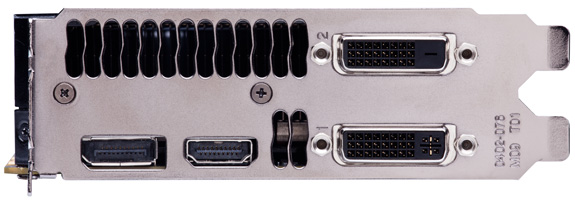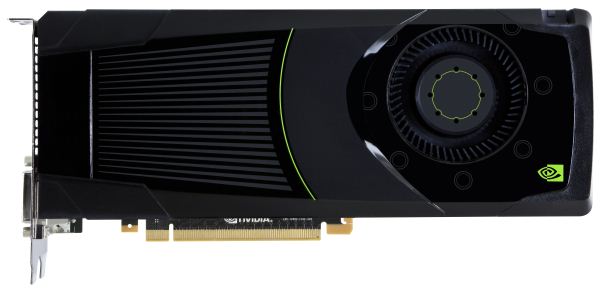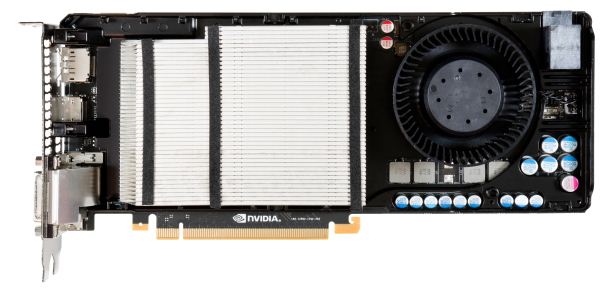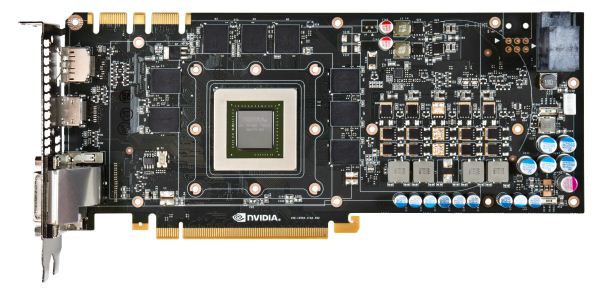NVIDIA GeForce GTX 680 Review: Retaking The Performance Crown
by Ryan Smith on March 22, 2012 9:00 AM ESTMeet the GeForce GTX 680
All things considered the design of the GeForce GTX 680 is not a radical departure from the GTX 580, but at the same time it also has some distinct differences owing to the fact that its TDP is some 50W lower than GTX 580.
Like the past GTX x80 cards, the basic design of the GTX 680 is that of a blower. A radial fan at the rear of the card sucks in air and pushes it towards the front of the card. Notably, due to a combination of card length and the fan position, the “wedge” around the fan has been done away with. NVIDIA tells us that this shouldn’t significantly impact the cooling of the card, particularly since it has a lower TDP in the first place, but when used in SLI it will remove some of the breathing room than the GTX 580 enjoyed.
Looking at the fan itself, compared to the GTX 580 the fan has been moved from the center of the card to the top of the card. This is due to NVIDIA’s port configuration, which uses a stacked DVI connector that consumes what would have normally been part of the exhaust vent on the GTX 580. We’ll get into the port configuration more in a minute, but for the moment the significance is that because the GTX 680 only has half a vent NVIDIA has moved the fan to match the vent, which is why the fan has been moved up.
On that note, the repositioning of the fan also had its own ramifications. Because the fan is now so close to the top and at the same time so close to the rear, NVIDIA went with a unique method of arranging the PCIe power sockets. Rather than having them side-by-side as we’ve seen on countless NVIDIA cards in the past, the sockets are stacked on each other in a staggered configuration. With the fan otherwise occupying the space that one of the sockets would take up, this configuration allowed NVIDIA to have two sockets without lengthening the card just to fit another socket. Overall this staggered design is not too difficult to work with, though with one socket facing the opposite way it might require some cable repositioning if you have a well maintained cable run.
Moving on, when we remove the shroud on the GTX 680 we see the fan, baseplate, and heatsink in full detail. NVIDIA is using an aluminum fin stacked heatsink, very similar to what we saw on the GTX 580. Underneath the heatsink NVIDIA is using a set of three heatpipes to transfer heat between the GPU and the heatsink. This is as opposed to the vapor chamber on the GTX 580, and while this setup doesn’t allow empirical testing, given the high efficiency of vapor chambers it’s likely that this isn’t quite as efficient, though to what degree we couldn’t say.
Finally, after removing the fan, baseplate, and heatsink, we can see the PCB in full detail. Unlike GF110 and GF114, GK104 is not capped with an IHS, allowing for the heatsink to directly come in contact with the GPU die. Meanwhile arranged around the GPU we can see the 8 2Gb GDDR5 RAM modules that give the GTX 680 its 2GB of RAM. These are Hynix R0C modules, which means they’re rated for 6GHz, the stock memory speed for the GTX 680. Overall the card measures 10” long with no overhang from the shroud, making it 0.5” shorter than the GTX 580.
Looking at the top of the card, as always we see the SLI connectors. Following in the footsteps of the GTX 580, the GTX 680 features 2 SLI connectors, allowing for up to 3-way SLI.
Meanwhile at the front of the card we see the I/O bracket. As we alluded to previously, the GTX 680 uses a stacked DVI design here; NVIDIA has done everything they can to keep the DVI ports at the very bottom of the card to avoid impeding airflow, but the upper DVI port still occupies roughly 40% of what would otherwise be the vent. Altogether the GTX 680 features 2 DL-DVI ports, a full size HDMI port, and a full size DisplayPort.

While NVIDIA has used DVI and HDMI ports for quite some time, this is the first time NVIDIA has included DIsplayPort on a reference design. Unfortunately we find that this ruffles our feathers a bit, although this isn’t strictly NVIDIA’s fault. As we’ve covered in the past, DisplayPort comes in both a full size and miniDP configuration – AMD in particular has used miniDP since the Radeon HD 6800 series in 2010. And while we’re happy to see DisplayPort finally make it into an NVIDIA reference design, the fact that it’s a full size DisplayPort is less than encouraging because at this point in time DisplayPort has largely been replaced by miniDP.
Ultimately the fault for this lies more with the VESA than NVIDIA, but it’s indicative of a larger problem in the DisplayPort community in that both full size DP and miniDP are equally valid and equally capable ports. While full size DisplayPort has the distinction of coming first, thanks in large part to Apple it has largely been displaced by miniDP as the most common variant on source devices. The problem with this is that both miniDP and DisplayPort are now in wide use; wide, redundant use.
At this point desktop computers and video cards coming with full size DisplayPorts is silly at best, and frustrating at worst. The laptop guys aren’t going to give up miniDP due to the space savings, and there’s no significantly good reason to use DisplayPort on desktops when miniDP offers the same functionality. We would rather see the PC industry standardize on miniDP across all source devices, and thereby eliminate any ambiguity with regards to what cables or adaptors are necessary. DisplayPort adoption has been slow enough – having 2 variants of the port on source devices only makes it more confusing for everyone.
Finally, while we’re on the subject of display connectivity we quickly took a look at how the idle clockspeeds of GTX 680 are impacted by the use of multiple displays. With 2 displays GTX 680 can utilize its full idle clocks, but only if both displays are connected via a TMDS type connection (DVI/HDMI) and run with identical timings. But if different timings are used or if one display is connected via DisplayPort, then the GTX 680 will shift to its low power 3D clocks. However if we expand that to 3 monitors and enable NVIDIA Surround, then the GTX 680 can operate at full idle regardless of whether DisplayPort is used or not.













404 Comments
View All Comments
Slayer68 - Saturday, March 24, 2012 - link
Being able to run 3 screens off of one card is new for Nvidia. Barely even mentioned it in your review. It would be nice to see Nvidia surround / Eyefinity compared on these new cards. Especially interested in scaling at 5760 x 1080 between a 680 and 7970.....ati666 - Saturday, March 24, 2012 - link
does the gtx680 still have the same anisotropic filtering pattern like the gtx470/480/570/580 (octagonal pattern) or is it like AMDs HD7970 all angle-independent anisotropic filtering (circular pattern)?Ryan Smith - Saturday, March 24, 2012 - link
It's not something we were planning on publishing, but it is something we checked. It's still the same octagon pattern as Fermi. It would be nice if NVIDIA did have angle-independent AF, but to be honest the difference between that and what NVIDIA does has been so minor that it's not something we've ever been able to create a noticeable issue with in the real world.Now Intel's AF on the other hand...
ati666 - Saturday, March 24, 2012 - link
thank for the reply, now i can finally make a decision to buy hd7970 or gtx680..CeriseCogburn - Saturday, March 24, 2012 - link
Yes I thank him too for finally coming clean and noting the angle independent amd algorithm he's been fanboy over for a long time has absolutely no real world gaming advantage whatsoever.It's a big fat zero of nothing but FUD for fanboys.
It would be nice if notional advantages actually showed up in games, and when they don't or for the life of the reviewer cannot be detected in games, that be clearly stated and the insane "advantage" declared be called what it really is, a useless talking point of deception that fools purchasers instead of enlightening them.
The biased emphasis with zero advantage is as unscientific as it gets. Worse yet, within the same area, the "perfectly round algorithm" yielded in game transition lines with the amd cards, denied by the reviewer for what, a year ? Then a race game finally convinced him, and in this 7000 series release we find another issue the "perfectly round algorithm" apparently was attached to flaw with, a "poor transition resolution" - rather crudely large instead of fine like Nvidia's which casued excessive amd shimmering in game, and we are treated to that information only now after the 7000 series "solved" the issue and brought it near or up to the GTX long time standard.
So this whole "perfectly round algorithm" has been nothing but fanboy lies for amd all along, while ignoring at least 2 large IQ issues when it was "put to use" in game. (transition shading and shimmering)
I'm certain an explanation could be given that there are other factors with differing descriptive explanation, like the fineness of textural changes as one goes toward center of the image not directly affecting roundness one way or another, used as an excuse, perhaps the self deceptive justification that allowed such misbehavior to go on for so long.
_vor_ - Saturday, March 24, 2012 - link
Will you seriously STFU already? It's hard to read this discussion with your blatant and belligerent jackassery all over it.You love NVIDIA. Great. Now STFU and stop posting.
CeriseCogburn - Saturday, March 24, 2012 - link
Great attack, did I get anything wrong at all ? I guess not.silverblue - Monday, March 26, 2012 - link
Could you provide a link to an article based on this subject, please? Not an attack; just curious.CeriseCogburn - Tuesday, March 27, 2012 - link
http://www.anandtech.com/show/5261/amd-radeon-hd-7...http://forums.anandtech.com/showpost.php?p=3152067...
" So what then is going on that made Civ V so much faster for NVIDIA? Admittedly I had to press NVIDIA for this - performance practically doubled on high-end GPUs, which is unheard of. Until they told me what exactly they did, I wasn't convinced it was real or if they had come up with a really sweet cheat. It definitely wasn't a cheat.
If you recall from our articles, I keep pointing to how we seem to be CPU limited at the time. "
(YES, SO THAT'S WHAT WE GOT, THEY'RE CHEATING IT'S FAKE WE'RE CPU LIMITED- ALL WRONG ALL LIES)
Since AMD’s latest changes are focused on reducing shimmering in motion we’ve put together a short video of the 3D Center Filter Tester running the tunnel test with the 7970, the 6970, and GTX 580. The tunnel test makes the differences between the 7970 and 6970 readily apparent, and at this point both the 7970 and GTX 580 have similarly low levels of shimmering.
with both implementing DX9 SSAA with the previous generation of GPUs, and AMD catching up to NVIDIA by implementing Enhanced Quality AA (their version of NVIDIA’s CSAA) with Cayman. Between Fermi and Cayman the only stark differences are that AMD offers their global faux-AA MLAA filter, while NVIDIA has support for true transparency and super sample anti-aliasing on DX10+ games.
(AMD FINALLY CATCHES UP IN EQAA PART, NVIDIA TRUE STANS AND SUPER SAMPLE HIGH Q STUFF, AMD CHEAT AND BLUR AND BLUR TEXT)
Thus I had expected AMD to close the gap from their end with Southern Islands by implementing DX10+ versions of Adaptive AA and SSAA, but this has not come to pass.
( AS I INTERPRETED AMD IS WAY BEHIND STILL A GAP TO CLOSE ! )
AMD has not implemented any new AA modes compared to Cayman, and as a result AAA and SSAA continue to only available in DX9 titles.
Finally, while AMD may be taking a break when it comes to anti-aliasing they’re still hard at work on tessellation
( BECAUSE THEY'RE BEHIND IN TESSELLATION TOO.)
Don't forget amd has a tessellation cheat in their 7000 series driver, so 3dmark 11 is cheated on as is unigine heaven, while Nvidia does no such thing.
---
I do have more like the race car game admission, but I think that's enough helping you doing homework .
CeriseCogburn - Tuesday, March 27, 2012 - link
So here's more mr curious .." “There’s nowhere left to go for quality beyond angle-independent filtering at the moment.”
With the launch of the 5800 series last year, I had high praise for AMD’s anisotropic filtering. AMD brought truly angle-independent filtering to gaming (and are still the only game in town), putting an end to angle-dependent deficiencies and especially AMD’s poor AF on the 4800 series. At both the 5800 series launch and the GTX 480 launch, I’ve said that I’ve been unable to find a meaningful difference or deficiency in AMD’s filtering quality, and NVIDIA was only deficienct by being not quite angle-independent. I have held – and continued to hold until last week – the opinion that there’s no practical difference between the two.
It turns out I was wrong. Whoops.
The same week as when I went down to Los Angeles for AMD’s 6800 series press event, a reader sent me a link to a couple of forum topics discussing AF quality. While I still think most of the differences are superficial, there was one shot comparing AMD and NVIDIA that caught my attention: Trackmania."
" The shot clearly shows a transition between mipmaps on the road, something filtering is supposed to resolve. In this case it’s not a superficial difference; it’s very noticeable and very annoying.
AMD appears to agree with everyone else. As it turns out their texture mapping units on the 5000 series really do have an issue with texture filtering, specifically when it comes to “noisy” textures with complex regular patterns. AMD’s texture filtering algorithm was stumbling here and not properly blending the transitions between the mipmaps of these textures, resulting in the kind of visible transitions that we saw in the above Trackmania screenshot. "
http://www.anandtech.com/show/3987/amds-radeon-687...
WE GET THIS AFTER 6000 SERIES AMD IS RELEASED, AND DENIAL UNTIL, NOW WE GET THE SAME THING ONCE 7000 SERIES IS RELEASED, AND COMPLETE DENIAL BEFORE THAT...
HERE'S THE 600 SERIES COVERUP THAT COVERS UP 5000 SERIES AFTER ADMITTING THE PROBLEM A WHOLE GENERATION LATE
" So for the 6800 series, AMD has refined their texture filtering algorithm to better handle this case. Highly regular textures are now filtered properly so that there’s no longer a visible transition between them. As was the case when AMD added angle-independent filtering we can’t test the performance impact of this since we don’t have the ability to enable/disable this new filtering algorithm, but it should be free or close to it. In any case it doesn’t compromise AMD’s existing filtering features, and goes hand-in-hand with their existing angle-independent filtering."
NOW DON'T FORGET RYAN HAS JUST ADMITTED AMD ANGLE INDEPENDENT ALGORITHM IS WORTH NOTHING IN REAL GAME- ABSOLUTELY NOTHING.